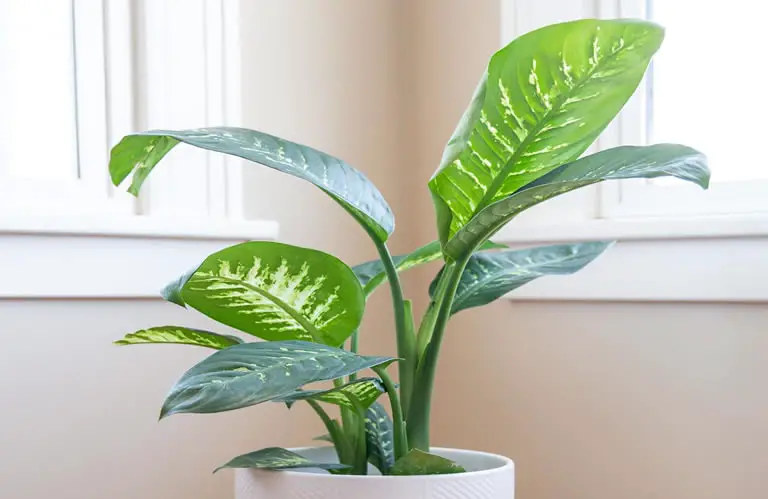Dieffenbachia, also known as Dumb Cane, is a lush, leafy houseplant known for its striking variegation and tall, tropical growth. Its bold, patterned leaves make it a natural focal point, and it can adapt to a variety of indoor conditions with minimal effort. While it’s not quite as indestructible as a cast iron plant, it’s still wonderfully easy to grow once you understand its preferences—especially when it comes to light and water.
Here’s how to care for Dieffenbachia indoors and out, plus how to keep it looking healthy and lush year-round.
Table of Contents
- Common Species & Their Varieties:
- Soft Light, Strong Growth: Lighting Needs for Vibrant Leaves
- Moist but Not Wet: How to Water Your Dumb Cane Properly
- Steady Conditions, Steady Growth: Temperature and Humidity Tips
- Feeding for Fullness: Fertilizing During the Growing Season
- Time for a New Pot: When to Repot Your Dieffenbachia
- Best Spot in the House: Where Dieffenbachia Looks and Feels Its Best
- Growing Dieffenbachia Outdoors: When to Move It Outside and How to Do It Right
- Common Dieffenbachia Problems and How to Fix Them
- Final Thoughts
Common Species & Their Varieties:
There are over 50 recognized species of Dieffenbachia, and dozens more cultivated varieties and hybrids—so you’ve got lots of options!
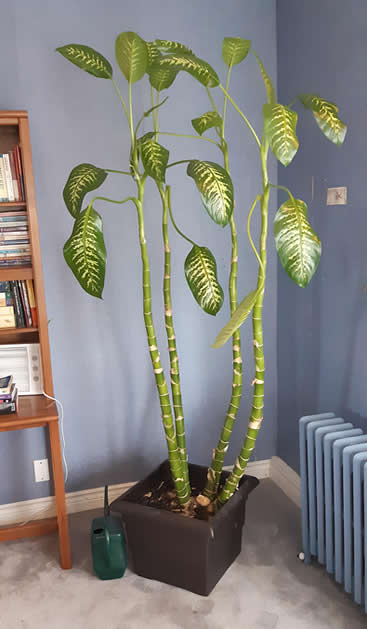
Most of what we see in homes and garden centers are cultivars of just a few main species, like:
-
Dieffenbachia seguine – One of the most widely grown species; large leaves with creamy variegation.
-
Dieffenbachia amoena – Big and bold with heavily patterned foliage.
-
Dieffenbachia maculata – Compact and often spotted or speckled.
-
Dieffenbachia ‘Camille’ – Creamy white centers with green borders.
-
Dieffenbachia ‘Tropic Snow’ – Big leaves, bold white-and-green contrast.
-
Dieffenbachia ‘Compacta’ – A smaller, more manageable version for tight spaces.
-
Dieffenbachia ‘Sterling’ – Sleek, silver-gray veining on dark green leaves.
-
Dieffenbachia ‘Mary’ – Fast-growing, super adaptable, and very popular.
Some new hybrids have even more intense colors—like yellow-tinged or nearly white leaves with splashes of green—and they’re constantly creating new ones through selective breeding.
Soft Light, Strong Growth: Lighting Needs for Vibrant Leaves
Dieffenbachia thrives in bright, indirect light but also tolerates medium-light spaces.
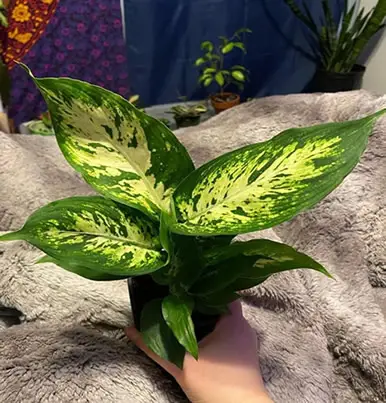
If the light is too low, you may notice slower growth and fading leaf patterns.
Too much direct sun, on the other hand, can scorch its soft leaves.
A few feet from an east- or north-facing window is ideal, or filtered light from a sheer curtain.
Moist but Not Wet: How to Water Your Dumb Cane Properly
Let the top inch or two of soil dry out between waterings.
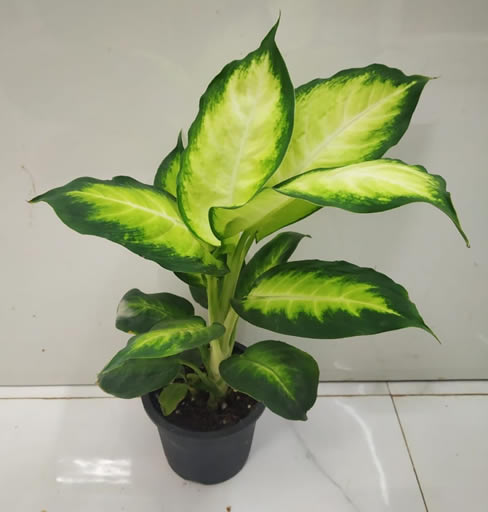
Dieffenbachia prefers consistently moist soil but reacts poorly to overwatering.
Soggy roots can lead to rot and yellowing leaves.
Use a well-draining potting mix, and always empty any excess water from saucers to prevent the roots from sitting in water.
Steady Conditions, Steady Growth: Temperature and Humidity Tips
Keep Dieffenbachia in warm, stable indoor temperatures between 65°F and 80°F.
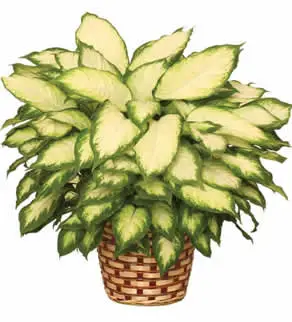
It does not like drafts, sudden cold, or dry air.
Average household humidity is usually fine, but during the drier winter months, a bit of misting or a humidity tray can help prevent crispy edges on the leaves.
Feeding for Fullness: Fertilizing During the Growing Season
Feed your Dieffenbachia once a month during spring and summer with a balanced, diluted liquid fertilizer.
Over-fertilizing can cause salt buildup in the soil, so don’t go overboard.
Use a good quality 20-20-20 fertilizer, like this one or a 10-10-10 fertilizer, such as this one,
Skip feeding in fall and winter when growth naturally slows.
Time for a New Pot: When to Repot Your Dieffenbachia
This plant grows fast under the right conditions and may need repotting every 1–2 years.
Look for signs like roots growing out of the bottom of the pot or the plant drying out too quickly.
When repotting, choose a container just one size larger and refresh the soil completely.
Best Spot in the House: Where Dieffenbachia Looks and Feels Its Best
Dieffenbachia is a perfect statement plant for living rooms, home offices, or bedrooms with filtered light.
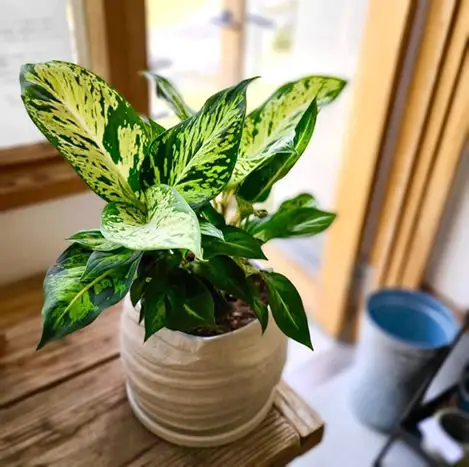
Its big, dramatic leaves bring height and volume to corners or next to furniture, and it looks especially striking in decorative pots on plant stands.
Growing Dieffenbachia Outdoors: When to Move It Outside and How to Do It Right
In USDA zones 10–12, Dieffenbachia can be grown outdoors year-round.
In cooler climates, it can spend summers outside in a shaded or partially shaded spot.
Avoid full sun, which can scorch the leaves.
Gradually acclimate it to outdoor conditions in spring, and be sure to bring it back inside when temperatures fall below 60°F.
Keep the soil evenly moist and be mindful of rainwater pooling in pots without good drainage.
Common Dieffenbachia Problems and How to Fix Them
Yellowing lower leaves
Often caused by overwatering or poor drainage
Fix it by letting the soil dry more between waterings and ensuring your pot has good drainage holes
Drooping or soft stems
Could be a sign of root rot from excessive moisture
Fix it by trimming off any mushy stems, repotting in dry, fresh soil, and watering less frequently
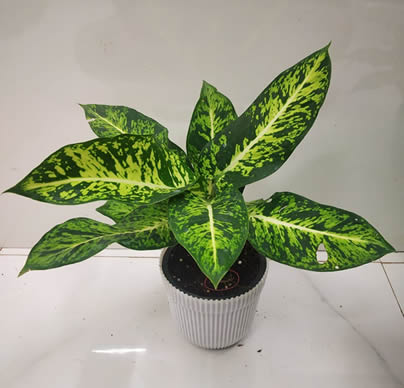
Brown or crispy leaf edges
Usually due to dry air or inconsistent watering
Fix it by misting the plant, increasing humidity, and watering more regularly
Pale, faded leaves
Often the result of too much direct sunlight
Fix it by moving the plant out of direct sun and into a spot with bright, filtered light
Leggy growth or wide spaces between leaves
A sign that the plant needs more light
Fix it by shifting it closer to a bright window without putting it in the sun’s direct path
Pests like spider mites or aphids
These can occasionally show up, especially in dry environments
Fix it by rinsing the leaves or treating with neem oil or insecticidal soap
Final Thoughts
Dieffenbachia is a bold, beautiful houseplant that fills a space with color and life without demanding too much from you in return.
Keep it warm, give it gentle light, and water it on a regular schedule, and you’ll be rewarded with lush, upright growth and statement-making foliage.
Just be sure to keep it out of reach of pets and kids, as its sap can be irritating if ingested—hence the nickname “Dumb Cane.”
Let me know if you want to cover propagation next, or if you’re ready to move on to another plant!

